As cyclists, we share a passion for the open road, the rugged trail, and the freedom that comes with two wheels beneath us. But as the years roll by, our bodies change, and so must our approach to cycling. This doesn’t mean hanging up your helmet – far from it! It means adapting smartly to continue enjoying the sport we love for decades to come.
Understanding the Physical Changes
First, let’s acknowledge what happens as we age. Starting around age 40, we typically lose 3-5% of muscle mass per decade, while our cardiovascular capacity gradually declines with lower maximum heart rate and VO2 max. Our joints undergo changes as cartilage thins and becomes less resilient, and perhaps most noticeably, our bodies require significantly more time to recover after intense cycling efforts.
Equipment Modifications Worth Considering
Bike Fit Adjustments
As we age, flexibility decreases, and comfort becomes increasingly important. Consider a more upright position to reduce back strain, with a shorter reach to the handlebars to alleviate neck and shoulder tension. Wider saddles often provide better support as sit bones lose natural padding over time.
E-Bike Options
E-bikes aren’t “cheating” – they’re smart adaptations that can extend your cycling years significantly, allow you to keep riding with younger, fitter groups, and help manage hills and headwinds that might otherwise be discouraging. They still provide excellent cardiovascular benefits when used appropriately.
Training Adaptations for Ageing Cyclists
Your 20-something training plan won’t serve you well in your 50s or 60s. Consider these adjustments:
As we age, recovery becomes paramount, shifting from the “hard-hard-hard” approach to a more sustainable “hard-easy-easy” pattern. Off-bike strength training grows increasingly crucial, with focus needed on core strength and functional movements that support cycling. Embracing cross-training activities like swimming, walking, or yoga helps maintain overall fitness while giving cycling-specific muscles a much-needed break. And as raw power naturally diminishes, efficient pedalling and skilful handling techniques become more important than ever.
Route Planning Considerations
Smart route choices can enhance enjoyment while reducing unnecessary strain. Consider moderating extremely technical descents on mountain bikes as reaction time and bone density change over time. Focus on quality rides rather than marathon sessions that require extensive recovery. Be increasingly mindful of weather conditions, as extreme heat and cold affect older riders more significantly. Design routes with multiple exit points in case you need to cut a ride short.
The Mental Game
Perhaps the most important adaptation involves your mindset. Instead of comparing yourself to your younger self, celebrate what your current self accomplishes each ride. Shift focus to the experience—appreciating the scenery, camaraderie, and joy of movement rather than just performance metrics. Most importantly, listen to your body; that nagging pain that you could ignore in your 30s deserves proper attention in your 50s.
Personal Perspective
At 60, I’ve adapted my riding significantly over the past decade. My mountain bike now has slightly wider tires run at lower pressure for better stability and comfort. I’ve shortened my stem and raised my handlebars. I ride fewer days per week but make each ride count. Most importantly, I’ve stopped comparing Strava segments to my personal bests from years ago and instead focus on the sheer joy of still being able to climb that challenging local trail or complete that scenic loop.
The reward? I’m still riding regularly while many of my formerly faster friends have quit altogether due to injuries or frustration.
Final Thoughts
Ageing doesn’t signal the end of your cycling journey – it merely charts a new course. By adapting intelligently, you can continue to enjoy this magnificent sport for decades to come. The key is to work with your changing body rather than against it.
How have you adapted your riding as you’ve gotten older? Share your experiences in the comments below!
Written by Niall O’Riordan UBS
